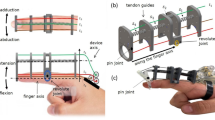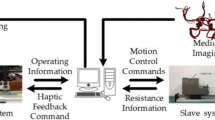Abstract
In this paper, an impedance-controlled multi-master/single-slave telerobotic system is developed for haptics-enabled surgical training and cooperation in beating-heart surgery. This system not only can enable automatically motion compensation for the beating heart’s motion as well as non-oscillatory force feedback to the human operators but can also enable training and cooperation for multiple users. A multi-user shared control architecture is developed, and a multilateral impedance-controlled strategy is employed for this architecture. The desired objectives of the proposed system are (a) providing position guidance to the trainees during training procedure, (b) providing force feedback to all human operators (trainer and trainees) regardless of their levels of authority over the slave robot, (c) motion compensation for the heart’s motion, and (d) reflecting only the non-oscillatory force portion of the slave-heart tissue interaction force to all human operators. To this end, virtual fixtures and a dominance factor are introduced, and a reference impedance model with adjusted parameters is designed for each master or slave robot. The proposed impedance-based control methodology is evaluated experimentally. The experimental results demonstrated that the proposed method could be used for surgical training and cooperation in beating-heart surgery by providing appropriate position guidance and environmental force feedback to the human operators.







Similar content being viewed by others
References
Shamaei, K., Kim, L.H., Okamura, A.M.: Design and evaluation of a trilateral shared-control architecture for teleoperated training robots. In: 2015 37th annual international conference of the IEEE engineering in medicine and biology society (EMBC), pp 4887–4893, (2015)
Shahbazi, M., Atashzar, S.F., Patel, R.V.: A dual-user teleoperated system with virtual fixtures for robotic surgical training. In: 2013 IEEE international conference on robotics and automation (ICRA), pp 3639–3644, (2013)
Shahbazi, M., Atashzar, S.F., Tavakoli, M., Patel, R.V.: Robotics-assisted mirror rehabilitation therapy: a therapist-in-the-loop assist-as-needed architecture. IEEE/ASME Trans. Mechatron. 21(4), 1954–1965 (2016)
Newman, M.F., Kirchner, J.L., Phillips-Bute, B., Gaver, V., Grocott, H., Jones, R.H., Mark, D.B., Reves, J.G., Blumenthal, J.A.: Longitudinal assessment of neurocognitive function after coronary-artery bypass surgery. N. Engl. J. Med. 344(6), 395–402 (2001)
Bachta, W., Renaud, P., Laroche, E., Forgione, A., Gangloff, J.: Active stabilization for robotized beating heart surgery. IEEE Trans. Rob. 27(4), 757–768 (2011)
Yuen, S.G., Kettler, D.T., Novotny, P.M., Plowes, R.D., Howe, R.D.: Robotic motion compensation for beating heart intracardiac surgery. Int. J. Robot. Res. 28(10), 1355–1372 (2009)
Yang, B., Liu, C., Zheng, W., Liu, S.: Motion prediction via online instantaneous frequency estimation for vision-based beating heart tracking. Inf. Fusion 35, 58–67 (2017)
Yuen, S.G., Perrin, D.P., Vasilyev, N.V., Pedro, J., Howe, R.D.: Force tracking with feed-forward motion estimation for beating heart surgery. IEEE Trans. Rob. 26(5), 888–896 (2010)
Horiuchi T, Tuna EE, Masamune, K., Çavuşoğlu, M.C.: Heart motion measurement with three dimensional sonomicrometry and acceleration sensing. In: 2012 IEEE/RSJ International conference on intelligent robots and systems (IROS), pp 4143–4149 (2012)
Bebek, O., Cavusoglu, M.C.: Intelligent control algorithms for robotic-assisted beating heart surgery. IEEE Trans. Rob. 23(3), 468–480 (2007)
Nakajima, Y., Nozaki, T., Ohnishi, K.: Heartbeat synchronization with haptic feedback for telesurgical robot. IEEE Trans. Ind. Electron. 61(7), 3753–3764 (2014)
Mansouri, S., Farahmand, F., Vossoughi, G., Ghavidel, A.A.: A hybrid algorithm for prediction of varying heart rate motion in computer-assisted beating heart surgery. J. Med. Syst. 42(10), 200 (2018)
Cheng, L., Tavakoli, M.: Ultrasound image guidance and robot impedance control for beating-heart surgery. Control Eng. Pract. 81, 9–17 (2018a)
Bowthorpe, M., Tavakoli, M.: Generalized predictive control of a surgical robot for beating-heart surgery under delayed and slowly-sampled ultrasound image data. IEEE Robot. Automation Lett. 1(2), 892–899 (2016)
Kesner, S.B., Howe, R.D.: Robotic catheter cardiac ablation combining ultrasound guidance and force control. Int. J. Robot. Res. 33(4), 631–644 (2014)
Cortesao, R., Dominici, M.: Robot force control on a beating heart. IEEE/ASME Trans. Mechatron. 22(4), 1736–1743 (2017)
Cheng, L., Sharifi, M., Tavakoli, M.: Towards robot-assisted anchor deployment in beating-heart mitral valve surgery. Int. J. Med. Robot. Comput. Assisted Surg. 14(3), e1900 (2018)
Cheng, L., Tavakoli, M.: Switched-impedance control of surgical robots in teleoperated beating-heart surgery. J. Med. Robot. Res. 3, 1841003 (2018b)
Nudehi, S.S., Mukherjee, R., Ghodoussi, M.: A shared-control approach to haptic interface design for minimally invasive telesurgical training. IEEE Trans. Control Syst. Technol. 13(4), 588–592 (2005)
Fracczak, L., Szaniewski, M., Podsedkowski, L.: Share control of surgery robot master manipulator guiding tool along the standard path. Int J Med Robot Comput Assisted Surg 15, e1984 (2019)
Khademian, B., Hashtrudi-Zaad, K.: Shared control architectures for haptic training: performance and coupled stability analysis. Int. J. Robot. Res. 30(13), 1627–1642 (2011)
Khademian, B., Hashtrudi-Zaad, K.: Dual-user teleoperation systems: new multilateral shared control architecture and kinesthetic performance measures. IEEE ASME Trans. Mechatron. 17(5), 895 (2012)
Ghorbanian, A., Rezaei, S.M., Khoogar, A.R., Zareinejad, M., Baghestan, K.: A novel control framework for nonlinear time-delayed dual-master/single-slave teleoperation. ISA Trans. 52(2), 268–277 (2013)
Shahbazi, M., Atashzar, S. F., Talebi, H. A., Patel, R. V.: An expertise-oriented training framework for robotics-assisted surgery. In: 2014 IEEE international conference on robotics and automation (ICRA), pp 5902–5907 (2014)
Shahbazi, M., Atashzar, S.F., Ward, C., Talebi, H.A., Patel, R.V.: Multimodal sensorimotor integration for expert-in-the-loop telerobotic surgical training. IEEE Trans. Rob. 34(6), 1549–1564 (2018)
Sharifi, M., Salarieh, H., Behzadipour, S., Tavakoli, M.: Stable nonlinear trilateral impedance control for dual-user haptic teleoperation systems with communication delays. J. Dyn. Syst. Meas. Contr. 139(12), 121012 (2017)
Hashemzadeh, F., Sharifi, M., Tavakoli, M.: Nonlinear trilateral teleoperation stability analysis subjected to time-varying delays. Control Eng. Pract. 56, 123–135 (2016)
Zakeri, E., Moezi, S.A., Eghtesad, M.: Optimal interval type-2 fuzzy fractional order super twisting algorithm: a second order sliding mode controller for fully-actuated and under-actuated nonlinear systems. ISA Trans. 85, 13–32 (2019)
Li, Z., Ding, L., Gao, H., Duan, G., Su, C.Y.: Trilateral teleoperation of adaptive fuzzy force/motion control for nonlinear teleoperators with communication random delays. IEEE Trans. Fuzzy Syst. 21(4), 610–624 (2013)
Liu, F., Lelevé, A., Eberard, D., Redarce, T.: A dual-user teleoperation system with online authority adjustment for haptic training. In: 2015 37th annual international conference of the IEEE engineering in medicine and biology society (EMBC), pp 1168–1171 (2015)
Li, Z., Xia, Y., Wang, D., Zhai, D.H., Su, C.Y., Zhao, X.: Neural network-based control of networked trilateral teleoperation with geometrically unknown constraints. IEEE Trans. Cybern 46(5), 1051–1064 (2016)
Khademian, B., Hashtrudi-Zaad, K.: A framework for unconditional stability analysis of multimaster/multislave teleoperation systems. IEEE Trans. Rob. 29(3), 684–694 (2013)
Shahbazi, M., Atashzar, S.F., Talebi, H.A., Patel, R.V.: Novel cooperative teleoperation framework: multi-master/single-slave system. IEEE/ASME Trans. Mechatron. 20(4), 1668–1679 (2015)
Bowthorpe, M., Castonguay-Siu, V., Tavakoli, M.: Development of a robotic system to enable beating-heart surgery. J. Robot. Soc. Jpn 32(4), 339–346 (2014)
Acknowledgements
This work is supported by the Canada Foundation for Innovation (CFI) under Grant LOF 28241 and JELF 35916, the Alberta Innovation and Advanced Education Ministry under Small Equipment Grant RCP-12-021, the Alberta Innovation and Advanced Education Ministry under Small Equipment Grant RCP-17-019, the Natural Sciences and Engineering Research Council (NSERC) of Canada under grant RGPIN 372042, the Natural Sciences and Engineering Research Council (NSERC) of Canada under grant RGPIN 03907, and the China Scholarship Council (CSC) under grant [2015]08410152.
Funding
This study was funded by the Canada Foundation for Innovation (CFI) under Grant LOF 28241 and JELF 35916, the Alberta Innovation and Advanced Education Ministry under Small Equipment Grant RCP-12-021, the Alberta Innovation and Advanced Education Ministry under Small Equipment Grant RCP-17-019, the Natural Sciences and Engineering Research Council (NSERC) of Canada under grant RGPIN 372042, the Natural Sciences and Engineering Research Council (NSERC) of Canada under grant RGPIN 03907, and the China Scholarship Council (CSC) under grant [2015]08410152.
Author information
Authors and Affiliations
Corresponding author
Ethics declarations
Conflict of interest
The authors declare that they have no conflict of interest.
Additional information
Publisher's Note
Springer Nature remains neutral with regard to jurisdictional claims in published maps and institutional affiliations.
Electronic supplementary material
Below is the link to the electronic supplementary material.
Supplementary material 1 (MP4 135506 kb)
Rights and permissions
About this article
Cite this article
Cheng, L., Tavakoli, M. A multilateral impedance-controlled system for haptics-enabled surgical training and cooperation in beating-heart surgery. Int J Intell Robot Appl 3, 314–325 (2019). https://doi.org/10.1007/s41315-019-00099-y
Received:
Accepted:
Published:
Issue Date:
DOI: https://doi.org/10.1007/s41315-019-00099-y




